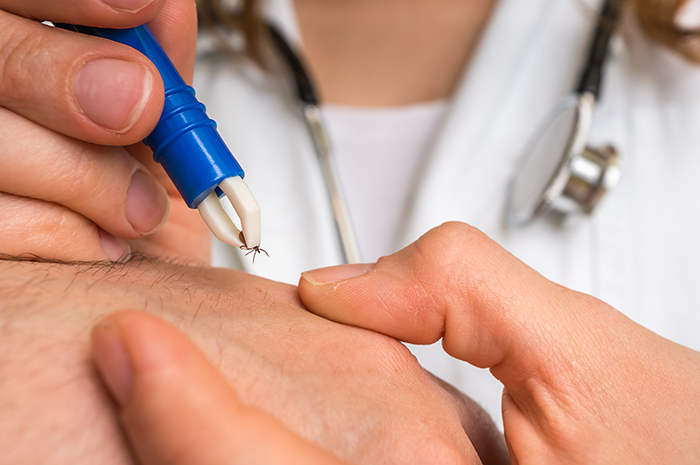Lyme Disease: What Floridians Need to Know

You’ve just visited family up north or spent the weekend hiking in North Florida. You made great memories, but that flu-like feeling isn’t one of them. It’s probably just a case of post-travel fatigue, right?
Maybe, or maybe not. If you live in South Florida, Lyme disease (LD) isn’t necessarily on your radar. However, the blacklegged tick that causes LD is common in Florida, as are other ticks that transmit disease. And it’s estimated that about 300,000 people are infected annually in the U.S. While most cases occur in North or Central Florida, the majority of Floridians are infected when visiting northern states, hence the nickname “Snowbird’s disease”.
Because the condition is less common in Florida and its symptoms mimic those of other diseases, it’s easy to overlook. Nearly half of Lyme cases are misdiagnosed in the early phase, when treatment is most beneficial.
There is an upside. Simple precautions can help you avoid Lyme disease. It’s also treatable if caught early. “The long-term consequences of Lyme disease are serious, so it’s important to be aware of this and other tick-borne diseases. I’ve treated patients infected by deer ticks after they visited the Florida Keys, for example,” says Dr. Schartess Culpepper Pace, a rheumatologist with the University of Miami Health System.
Signs and symptoms of lyme disease
The most common early sign is a circular, spreading “bull’s eye” rash. It usually (but not always) appears at the bite area. Other symptoms mimic the flu. These include:
- Fatigue
- Chills
- Fever
- Body aches
As the disease progresses, it causes joint pain, swelling or stiffness. That’s when most people seek the help of a rheumatologist like Dr. Culpepper. Others experience cramps, twitching, muscle pain or restless legs. In later stages, symptoms may cause headaches, numbness, dizziness, memory loss, partial paralysis and stroke-like symptoms. LD can also cause vision, hearing, respiratory and psychological problems.
Prevention is key
Even non-hikers aren’t out of the woods when it comes to LD. “I treated a cyclist for knee pain resulting from Lyme disease. You wouldn’t think a tick could bite someone on a bike, but they are crawling insects,” Dr. Culpepper says.
To avoid ticks, follow these guidelines:
- Avoid walking in wooded areas with tall weeds or brush. Stick to pathways.
- When hiking, wear light-colored long sleeve shirts and long pants and tuck pants inside your socks.
- Wear a hat.
- Spray clothing and exposed skin with a repellent containing DEET, Picaridin or IR3535. Or try a spray containing lemon, eucalyptus or cedar essential oil. Note: Talk to your pediatrician before using synthetic or natural sprays on infants and toddlers.
- After spending time in tick-infested areas, toss your clothes in the dryer for 20 minutes or place them in a sealed bag, then transfer to the dryer later.
- Do a full body check, especially armpits, groin, naval, between toes, behind knees, skin creases, back of neck and in your hair. Some ticks are no bigger than a poppy seed, so scan carefully!
- Shower or bathe thoroughly.
If you find a tick, follow these steps:
- Using tweezers or a tick removal tool, gently grasp the insect out from where it’s attached. Do not twist.
- Do not use nail polish, oils, heat or other liquids to remove ticks.
- If possible, put the tick in a sealed plastic bag and bring to your doctor.
- Disinfect hands, tweezers and the bite site after removal.
- If the tick remains fully or partially embedded, see a doctor immediately. Ticks can transmit disease within 36-48 hours.
- Even if the insect is completely removed, see your doctor if you experience any flu-like symptoms. If you’re not getting answers or if symptoms persist, see an infectious disease specialist or rheumatologist.
Detecting and treating a deceptive disease
“As a large university-based health system, medically complex conditions like Lyme disease are on our radar. However, if a doctor doesn’t suspect Lyme or the patient doesn’t realize they were exposed, the doctor won’t test for the disease because the symptoms are so non-specific,” says Dr. Culpepper. Lab testing is recommended if the doctor suspects Lyme disease or the patient has history of possible exposure. Testing of the tick itself may be less reliable, if the patient was bitten by multiple ticks.
Dr. Culpepper treats patients prophylactically if she suspects tick-borne illness. “If there’s a high index of suspicion, we don’t wait for testing. We give patients Doxycycline and monitor their response.” If symptoms remain, she repeats the process with Amoxicillin. Patients with advanced neurological symptoms require antibiotic IV therapy.
Ultimately, Dr. Culpepper believes patients themselves provide the best clues. “Always tell your doctor if you’ve traveled or have been around pets or people who may have come in contact with ticks.”
Nancy Moreland is a regular contributor to UMiami Health News. She has written for several major health care systems and the Centers for Disease Control and Prevention. Her writing also appears in the Chicago Tribune.
Tags: Dr. Schartess Culpepper Pace, Lyme disease, tick bites, tick borne illness
